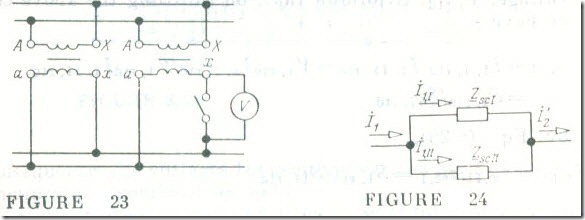Transformers in Parallel
When two (or more) transformers are used in parallel, their primary windings are energized from a common source (a common power line in Fig.23), and their secondary windings are connected across a common load (a common line in Fig 23).
Transformers to be brought in for parallel operation should meet three conditions of which one is mandatory and the remaining two permit some variations. These conditions are as follows.
(1) The transformers should have the same phase displacement , that is belong to the same reference group (for three-phase transformers , this should be either reference group 0 or 11).
(2) The transformers should have the same rated primary and secondary voltages, and the difference in transformation ratio ought not to exceed 0.5 %.
(3) the transformers should have the same impedance voltage (to within ± 10%).
Meeting the first two conditions avoids heavy circulating currents in the transformer windings which would otherwise flow at no-load if the paralleled transformers belonged 10 displacement phase displacement groups or differed ill secondary emfs .
For single-phase units, a further requirement is the correct polarity on the secondary side. This requirement is checked as follows. One single-phase transformer is connected in parallel with another as shown in Fig.23, and a voltmeter is placed in parallel with the knife-blade switch which serves to turn On the second transformer . If the secondary connection is correct. the voltmeter will read zero: otherwise the voltmeter will read twice the secondary voltage of the transformer .
In the case of failure to meet the first requirement when connecting in parallel two three-phase units, the phase displacement between the secondary line voltages will he 30°. Therefore a resultant emf will be induced in each loop formed by two phase windings (of the two transformers). Since the resistance of the windings is small, this emf will produce a very heavy current detrimental to the transformer windings.
It is important to satisfy the third condition in order that the load will be shared between the parallel transformers in proportion to their apparent power ratings. In the simplified equivalent circuit of Fig. 17 a transformer is represented by a circuit in which the complex short-circuit impedance is Zsc ( see Sec. 7). Two transformers in parallel may be shown in n common equivalent circuit as two parallel branches containing short-circuit impedance Zsc,I and Zsc,II (Fig. 24). With this arrangement, the rms currents I1,I and I1,II are inversely proportional to the impedances of the parallel branches
I1,I/I1,II = zsc,II /zsc,I (8.25)
The impedance voltage of a transformer is proportional to the product of the rated primary current I1,rtd by its short-circuit impedance ZSC . If the two paralleled transformers have the same impedance voltage, then
zsc,I I I,rtd = zsc,II I1,II,rtd
Since the transformers in parallel should have the same primary rated voltage, V1,rtd it follows that, on fulfilling the above condition, we have
Zsc,II/ Zsc,I =I1,I,rtd/ I1,Irtd = V1,rtdI1, I,rtd /Vl,rtdI1, II,rtd
= S I,rtd/ SII,rtd
and, by Eq. (8.25),
I1,I/ I1,II = Zsc,II/Zsc,I = SI,rtd/SII,rtd
That is, the currents are shared between the paralleled transformers in proportion to their apparent power ratings. In other words, the equality of impedance voltages provides for the distribution of load between the paralleled transformers in proportion to their apparent power ratings.

